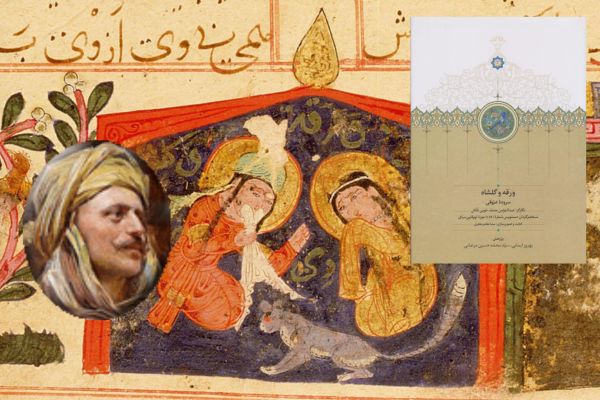About ʿAyyūqī:
ʿAyyūqī, an 11th-century Persian poet, is best known for his romantic poem Varqa o Golšāh, a love story steeped in the medieval Persian literary tradition. His work, believed to have been influenced by Ferdowsī’s Shāhnāma, combines Persian philology and narrative innovations, such as the interspersion of ghazals within the story, which was a novel approach at the time.
The story of Varqa o Golšāh follows the ill-fated love of Varqa and Golšāh, two young Arabs who face separation, conflict, and ultimately death due to circumstances beyond their control. The text suggests that ʿAyyūqī adapted this tale from earlier Arabic sources, rooted in the legend of ʿOrwa and ʿAfrā, another pair of doomed lovers celebrated in pre-Islamic Arab lore. With over 2,200 verses, the poem stands out as a notable piece of Persian romance, though it lacks some of the thematic complexity found in similar works by later poets such as Neẓāmī.
The single surviving illustrated manuscript, now housed in Istanbul, dates back to the 13th century and has attracted scholarly attention for its colorful miniatures. This manuscript not only serves as a cultural artifact but also provides insights into the spoken and written Persian of ʿAyyūqī’s time.
Despite ʿAyyūqī’s limited known works, his contributions to Persian literature are recognized, particularly for helping to popularize romance narratives within Persian poetry and influencing subsequent generations of poets in the Persian-speaking world.
Ayyuqi was a poet from the early 5th century AH and the author of the romantic masnavi poem Varka and Golshah. Not much is known about his life. He dedicated his masnavi to Sultan Mahmud, and because he refers to this sultan by the title "Abul Qasim" and "Sultan Ghazi," it is undoubtedly Sultan Mahmud of Ghazni (387–421 AH). According to Ahmad Ateş, Ayyuqi composed Varka and Golshah at Nowruz and presented it as a festive gift to Sultan Mahmud. Safa also identifies Sultan Ghazi as Mahmud for similar reasons, believing that the language and expressions within the masnavi reinforce this view. However, some believe that the Sultan Mahmud to whom Ayyuqi dedicated the poem may be Mahmud ibn Malikshah Seljuk (486–487 AH).
Ayyuqi is renowned for composing the romantic epic Varka and Golshah, but little is known about the details of his life. He wrote another masnavi in the ramal meter and composed several qasidas (odes) as well. In a section of Varka and Golshah, Ayyuqi references his own unfulfilled love and expresses grievances about his time and the "inhumanity" of certain people who hindered his happiness.
The accessible language and descriptions in Ayyuqi’s work, such as Golshah cooking for Varka even though she is the queen of Sham, suggest that Ayyuqi was from the middle or lower social classes.
Varka and Golshah is a Persian romantic epic with over two thousand verses in the mutaqarib meter. It is one of the earliest narrative masnavi poems in Persian, written during the 4th and early 5th centuries AH. Ayyuqi drew on Arabic tales for Varka and Golshah, and its source is considered similar to the Arabic origin of Nezami’s Layli and Majnun.
The story bears a close resemblance to the classic Arabic love tale of 'Urwah and 'Afra, which was well-known in the 4th century. According to Ayyuqi, Varka and Golshah is based on 'Urwah and 'Afra. The poem tells a love story in straightforward language, contrasting with Nezami’s Layli and Majnun, which uses metaphor, allusion, and numerous literary devices.
The first sixteen lines of Varka and Golshah, which praise God and the Prophet of Islam, were added later and are selections from the verses of Homa and Homayun, composed by the 8th-century poet Khwaju Kermani. In these sixteen lines, unlike the rest of the Varka and Golshah manuscript, the letters “پ” and “چ” appear with three dots, and all “ذ” letters are written as “د” except in the word for God (Khoda).
Varka and Golshah is also significant in the history of Persian painting and illustration because the unique illustrated copy of this masnavi includes 71 miniatures. This copy, located in the Topkapi Palace Library in Istanbul, numbered hezine 841, is considered by some researchers to be the oldest illustrated Persian manuscript to have survived in good condition.
Sokhanvar information
Published on Nov. 8, 2024, 5:11 a.m. by @hamed
- Name: Ayyughi
- Persian Name:: نام به فارسی
- Alias: Ayyūqī
- Comments: 0
- Views: 589
Works
The story of Varqa o Golšāh follows the ill-fated love of Varqa and Golšāh, two young Arabs who face separation, conflict, and ultimately death due to circumstances beyond their control. The text suggests that ʿAyyūqī adapted this tale from earlier Arabic sources, rooted in the legend of ʿOrwa and ʿAfrā, another pair of doomed lovers celebrated in pre-Islamic Arab lore. With over 2,200 verses, the poem stands out as a notable piece of Persian romance, though it lacks some of the thematic complex
Books
- No books added yet.

